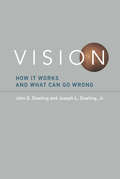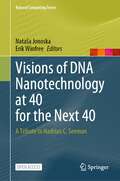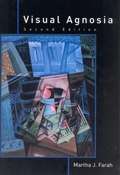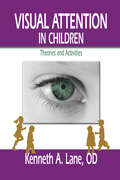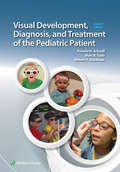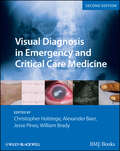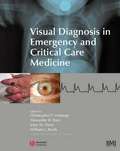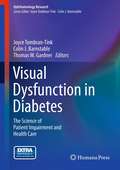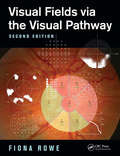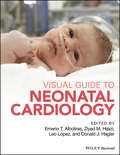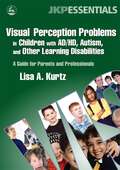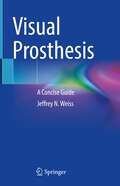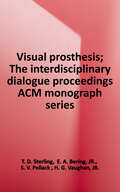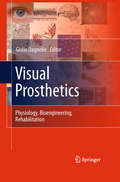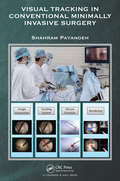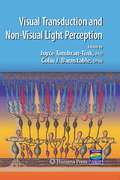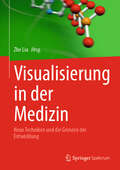- Table View
- List View
Vision: How It Works and What Can Go Wrong
by John E. Dowling Joseph L. DowlingDescriptions of basic visual mechanisms and related clinical abnormalities, by a neuroscientist and an ophthalmologist.Over the past fifty years, enormous progress has been made in understanding visual mechanisms and treating eye disorders. And yet the scientist is not always aware of the latest clinical advances and the clinician is often not up to date on the basic scientific discoveries. Writing in nontechnical language, John and Joseph Dowling, a neuroscientist and an ophthalmologist, examine vision from both perspectives, providing concise descriptions of basic visual mechanisms and related clinical abnormalities. Thus, an account of the photoreceptors is followed by a consideration of retinitis pigmentosa and macular degeneration; an explanation of the retina's function is followed by details of glaucoma and diabetic retinopathy.The authors begin with the cornea and lens, which project an image on the light-sensitive elements inside the eye, the photoreceptors, and how that process can be compromised by such disorders as cataracts and corneal disease. They go on to describe, among other things, how the photoreceptors capture light; retinal and visual cortical anatomy and physiology; and higher level visual processing that leads to perception. Cortical disorders such as amblyopia are discussed as well as specific deficits such as the inability to recognize faces, colors, or moving objects. Finally, they survey the evolution of our knowledge of vision, and speculate about future advances.
Visions of DNA Nanotechnology at 40 for the Next 40: A Tribute to Nadrian C. Seeman (Natural Computing Series)
by Nataša Jonoska Erik WinfreeThis open access book provides a unique and state-of-the-art view on DNA nanotechnology with an eye toward future developments. Intended as a tribute to Nadrian C. Seeman, who founded the field of DNA nanotechnology, the content is an exciting mixture of technical and non-technical material, reviews, tutorials, perspectives, new findings, and open questions. The book aims to inspire current researchers to sit back and think about the big picture, while also enticing new researchers to enter the field. Most of all, the book captures voices from a unique moment in time: 40 years after the publication of the first paper that envisioned DNA nanotechnology.From this vantage point, what are the untold stories, the unspoken concerns, the underlying fundamental issues, the overlooked opportunities, and the unifying grand challenges? What will help us see more clearly, see more creatively, or see farther? What is transpiring right now that could pave the way for the future? To address these questions, leading researchers have contributed 22 chapters, grouped into five sections: perspectives, chemistry and physics, structures, biochemical circuits, and spatial systems.This book will be an important reference point in the field of DNA nanotechnology, both for established researchers looking to take stock of the field and its future, and for newcomers such as graduate students and researchers in other fields who are beginning to appreciate the power and applicability of its methods.
Visite! - Kommunikation auf Augenhöhe im interdisziplinären Team
by Alexander ForsterGeballte Fachkompetenz!Dieses Buch zeigt Pflegenden, Ärzten und weiteren Mitgliedern der Gesundheitsfachberufe, wie man eine Visite effizient und erfolgreich im Team durchführen kann. Dabei ist eine sinnvolle Rollenverteilung genauso wichtig, wie die örtlichen Rahmenbedingungen und zeitlichen Absprachen.
Visual Agnosia (Second Edition)
by Martha J. FarahThe second edition of the classic book on visualagnosia, updated to include disorders of semantic knowledge andtopographic recognition, and integrating perspectives from functional neuroimaging throughout.
Visual Attention in Children: Theories and Activities
by Kenneth LaneIn typical child development, attention controls many aspects of learning, including memory, motor control, and problem solving. Attention organizes the constant influx of information that needs to be absorbed by children. Inside Visual Attention in Children: Theories and Activities, Dr. Kenneth A. Lane describes the positive aspects of attention that are needed for children to be successful in the classroom, such as concentration and vigilance, as opposed to negative aspects that can lead to failure, such as distractibility and confusion. This book is divided into two parts. The first eight chapters of the book explain attention and its relationship to vision and visual stimuli. The core topics discussed here include Autism, ADHD, Dyslexia, Executive Function, and Memory. The second half outlines a Vision Therapy program and consists of activities for improving visual attention in children. Over 100 activities are explained and illustrated.Visual Attention in Children: Theories and Activities is anchored on current theories in five areas of attention that shape child development.Theories Described Include:• Focused Attention – The ability to respond discreetly to visual, auditory, and tactile stimuli• Selective Attention – The ability to maintain behavioral or cognitive abilities in the face of distracting or competing stimuli• Shifting Attention – The ability to rapidly shift attention from one object to another• Sustained Attention – The ability to maintain a consistent behavioral response during a continuous or repetitive activity• Divided Attention –The ability to engage in more than one attention-focused task at one time.Visual Attention in Children: Theories and Activities is the perfect tool for occupational therapy students and clinicians as well as other professionals specializing in child development and learning who are looking to enhance their understanding of this topic and who need unique ideas and activities to add to their visual therapy training programs.
Visual Culture and Pandemic Disease Since 1750: Capturing Contagion (Science and the Arts since 1750)
by Marsha Morton Ann-Marie AkehurstThrough case studies, this book investigates the pictorial imaging of epidemics globally, especially from the late eighteenth century through the 1920s when, amidst expanding Western industrialism, colonialism, and scientific research, the world endured a succession of pandemics in tandem with the rise of popular visual culture and new media. Images discussed range from the depiction of people and places to the invisible realms of pathogens and emotions, while topics include the messaging of disease prevention and containment in public health initiatives, the motivations of governments to ensure control, the criticism of authority in graphic satire, and the private experience of illness in the domestic realm. Essays explore biomedical conditions as well as the recurrent constructed social narratives of bias, blame, and othering regarding race, gender, and class that are frequently highlighted in visual representations. This volume offers a pictured genealogy of pandemic experience that has continuing resonance. The book will be of interest to scholars working in art history, visual studies, history of medicine, and medical humanities.
Visual Development
by Nigel W. DawThe only book on the market to cover the psychophysics, anatomy, physiology, and clinical deficits of the developing visual system in an accessible format and length. The visual system is the most commonly studied aspect of the nervous system and is the primary model for the study of both normal development and the effects of environment and sensory deprivation on development. This third edition highlights new research and features a large number of illustrations, many in color. It can be used as a supplementary text in neuroscience and ophthalmology courses. This book is a great resource for both novice and advanced researchers in the field of vision.
Visual Development, Diagnosis, and Treatment of the Pediatric Patient
by Pam Schnell Marc B. Taub Robert H. DuckmanThis second comprehensive edition of Visual Development, Diagnosis, and Treatment of the Pediatric Patient combines basic concepts of vision development with clinical diagnosis and treatment of vision disorders in infants, toddlers, children, and adolescents. Heavily updated, with new sections on timely issues and topics, the book is ideal for anyone who needs to know the practical aspects of evaluation and care of pediatric patients.
Visual Diagnosis in Emergency and Critical Care Medicine
by William J. Brady Jesse M. Pines Alexander B. Baer Christopher P. HolstegeImprove your skills in visual diagnosisSpeed and accuracy of diagnosis is the key to saving lives in emergency and critical care medicine. Careful visual inspection of the patient, the data (radiography, electrocardiogram), and related clues can often help providers choose the right diagnosis and ultimately the best treatment - but this knowledge comes with experience. This book provides 110 randomly presented visual diagnosis cases for self-testing, imitating real-life situations found in the emergency department setting.Written by distinguished emergency and critical care physicians, and thoroughly revised and updated throughout, this second edition includes 25% new cases and is an ideal aid for trainees preparing for Board examinations as well as an invaluable 'refresher' for qualified emergency and critical care providers.
Visual Diagnosis in Emergency and Critical Care Medicine
by Facep Faaem William J. Brady Jesse M. Pines Alexander B. Baer Christopher P. Holstege FacmtContaining high quality images, this book presents the common visual diagnoses that are either pathognomonic or suggestive of specific illnesses. Organized randomly as a patient would present their 'chief complaint' rather than neatly into topics, this book is an invaluable aid for all health care personnel who manage patients in acute care settings. This book is also ideal for national examination review.
Visual Dysfunction in Diabetes
by Colin J. Barnstable Joyce Tombran-Tink Thomas W. GardnerAn exciting contribution to the field, Visual Dysfunction in Diabetes: The Science of Patient Impairment and Improvement is designed with two overriding objectives: to help readers understand the impact of vision impairment in people living daily with diabetes rather than considering diabetic retinopathy solely as a medical problem, and to explore what we know and don't know about the ways diabetes affect the eye. With the plethora of new information being generated, there are still a series of fundamental questions that must be addressed if effective treatments for diabetic retinopathy are to be found and applied. Developed by a renowned group of authorities, Visual Dysfunction in Diabetes: The Science of Patient Impairment and Improvement offers responses and context for a range of questions, such as: do metabolic factors beyond glucose contribute to vision-threatening diabetic retinopathy? If so, how do these lead to vision impairment? Is diabetic retinopathy a response to systemic metabolic abnormalities or are there unique ocular problems related to insulin resistance? What is the relationship between the neural, vascular, and inflammatory abnormalities in diabetic retinopathy? Do they represent a pathological cascade induced sequentially or simultaneous responses to one or more metabolic perturbations? The authors note that if we do not address these types of questions, it is possible that the long process of developing new therapeutics will target only one arm of the pathology and leave the retina open to damaging consequences of the others. State-of-the-art, comprehensive, and an invaluable addition the research and clinical literature, Visual Dysfunction in Diabetes: The Science of Patient Impairment and Improvement offers guidance and a significant step toward new scientific approaches that can lessen the devastating vision impairment associated with diabetes.
Visual Ergonomics Handbook
by Jeffrey AnshelViewing an electronic display screen varies significantly from reading text on paper and human eyes often suffer for it. Featuring cutting-edge research in the field of visual ergonomics, Visual Ergonomics Handbook focuses on vision and eye-care issues in both the office and industrial setting, including eye safety issues in industrial plants and c
Visual Fields via the Visual Pathway
by Fiona RoweVisual Fields via the Visual Pathway presents the varying visual field deficits occurring with lesions of the visual pathway. The book covers anatomy, pathology and signs and symptoms, plus visual field defects associated with specific parts of the visual pathway. Also covered is the basic theory of visual field assessment.This new edition includes
Visual Guide to Neonatal Cardiology
by Ernerio T. Alboliras Ziyad M. Hijazi Cecilio Leo Lopez Donald J. HaglerThe Visual Guide to Neonatal Cardiology is a comprehensive, highly illustrated, reference covering the evaluation, diagnosis and management of cardiac disease in the newborn. <p><p> Contains over 900 color illustrations, including patient photographs, chest roentgenograms, electrocardiograms, echocardiograms, angiocardiograms, 3D computed tomogramphy, magnetic resonance imaging, pathologic specimens, and other relevant visual aids <p> Discusses the natural history of fetal heart disease and the rationale, indications, technique, and impact of fetal cardiac intervention <p> Reviews the anatomy and physiology of the neonatal cardiovascular system, including differences within the fetal, transitional, neonatal, child and adult circulatory system <p> Highlights key steps for taking a patient history, including detailed discussion of the cardiac examination (inspection, palpation and auscultation of heart sounds and murmurs) <p> Presents over 35 morphologic conditions with sections covering introduction, epidemiology, etiology with accepted or postulated embryogenesis, pathophysiology, clinical presentation, physical examination findings, diagnostic evaluation, management, and prognosis <p> Includes a neonatal formulary reviewing selected medications currently used for treatment of perioperative low cardiac output, congestive heart failure, pulmonary hypertension, sedation, pain and anticoagulation in neonates
Visual Impairment: An Overview
by Ian L. Bailey Amanda HallA general, down-to-earth look at the common forms of vision loss and their impact on the individual. Explains the different aspects of visual impairment, describes adaptive techniques and devices, and provides information on available resources and services in a concise and easy-to-understand manner for busy professionals and visually impaired people and their families. Visual Impairment: An Overview seeks to clarify misconceptions and misunderstandings of the different aspects of visual impairment, describe adaptive techniques and devices, and provide information on available resources and services. Anyone with questions about vision loss will find this book a useful resource designed to increase understanding of visual impairment and the ability of visually impaired people to lead unimpaired lives.
Visual Perception Problems in Children with AD/HD, Autism, and Other Learning Disabilities: A Guide for Parents and Professionals
by Lisa A. KurtzThis book provides a comprehensive overview of vision problems in children with developmental disabilities such as AD/HD, autism spectrum disorders, and specific learning disabilities. Written in a very accessible style, it is appropriate for parents and professionals alike and offers non-technical explanations of how vision difficulties are screened for and advice on where to seek appropriate professional care. Lisa Kurtz outlines a range of activities for strengthening children's functional vision and perceptual skills using simple, homemade materials that are readily available in the home or classroom. This is an excellent practical companion for parents of children with visual perception problems and the professionals who work with them.
Visual Plague: The Emergence of Epidemic Photography
by Christos LynterisHow epidemic photography during a global pandemic of bubonic plague contributed to the development of modern epidemiology and our concept of the &“pandemic.&”In Visual Plague, Christos Lynteris examines the emergence of epidemic photography during the third plague pandemic (1894–1959), a global pandemic of bubonic plague that led to over twelve million deaths. Unlike medical photography, epidemic photography was not exclusively, or even primarily, concerned with exposing the patient&’s body or medical examinations and operations. Instead, it played a key role in reconceptualizing infectious diseases by visualizing the &“pandemic&” as a new concept and structure of experience—one that frames and responds to the smallest local outbreak of an infectious disease as an event of global importance and consequence. As the third plague pandemic struck more and more countries, the international circulation of plague photographs in the press generated an unprecedented spectacle of imminent global threat. Nothing contributed to this sense of global interconnectedness, anticipation, and fear more than photography. Exploring the impact of epidemic photography at the time of its emergence, Lynteris highlights its entanglement with colonial politics, epistemologies, and aesthetics, as well as with major shifts in epidemiological thinking and public health practice. He explores the characteristics, uses, and impact of epidemic photography and how it differs from the general corpus of medical photography. The new photography was used not simply to visualize or illustrate a pandemic, but to articulate, respond to, and unsettle key questions of epidemiology and epidemic control, as well as to foster the notion of the &“pandemic,&” which continues to affect our lives today.
Visual Prosthesis: A Concise Guide
by Jeffrey N. WeissFor the millions of people with untreatable blindness the thought of a visual prosthesis that would allow them to live a normal life has always been a distant hope. There have been intermittent bright spots that periodically fan that hope such as when Dr. Dobelle’s visual prosthesis patient drove a car in an empty parking lot. This book will serve as an update of the work in developing a visual prosthesis. Chapters discuss the physiologic and engineering issues, alternative strategies, and patents, as well as recent research studies. Visual Prosthesis - A Concise Guide is a must-have resource for ophthalmologists, neurologists, engineers and physicists.
Visual Prosthesis: The Interdisciplinary Dialogue, Proceedings (ACM monograph)
by Theodor D. SterlingThis book holds the proceedings of the second conference on the visual prosthesis.
Visual Prosthetics
by Gislin DagnelieVisual Prosthetics provides an in-depth analysis of the principles of operation, current state, anticipated developments, and functional aspects of visual prosthetics restoring sight to visually impaired individuals. This volume uniquely describes the human visual system in health and disease in a pedagogical and didactic manner, fitting to professionals and researchers with a bioengineering background. Readers will find a balanced overview of electrical, molecular chemical and synthetic chromophore stimulation, in addition to the biophysics and psychological aspects of vision restoration. Unlike competitive texts, this introduction also includes the need and methods for functional evaluation and rehabilitation. Professionals in the field of biomedical engineering and graduate and postgraduate researchers will find Visual Prosthetics a valuable reference.
Visual Tracking in Conventional Minimally Invasive Surgery
by Shahram PayandehVisual Tracking in Conventional Minimally Invasive Surgery introduces the various tools and methodologies that can be used to enhance a conventional surgical setup with some degree of automation. The main focus of this book is on methods for tracking surgical tools and how they can be used to assist the surgeon during the surgical operation. Various notions associated with surgeon–computer interfaces and image-guided navigation are explored, with a range of experimental results. The book starts with some basic motivations for minimally invasive surgery and states the various distinctions between robotic and non-robotic (conventional) versions of this procedure. Common components of this type of operation are presented with a review of the literature addressing the automation aspects of such a setup. Examples of tracking results are shown for both motion and gesture recognition of surgical tools, which can be used as part of the surgeon–computer interface. In the case of marker-less tracking, where no special visual markers can be added to the surgical tools, the tracking results are divided into two types of methodology, depending on the nature and the estimate of the visual noise. Details of the tracking methods are presented using standard Kalman filters and particle filters. The last part of the book provides approaches for tracking a region on the surgical scene defined by the surgeon. Examples of how these tracking approaches can be used as part of image-guided navigation are demonstrated. This book is designed for control engineers interested in visual tracking, computer vision researchers and system designers involved with surgical automation, as well as surgeons, biomedical engineers, and robotic researchers.
Visual Transduction And Non-Visual Light Perception
by Colin J. Barnstable Joyce Tombran-TinkThis book reveals not only how the eye evolved into an organ of vision, but also describes how molecular mechanisms of key molecules operate in the phototransduction cascade. In this groundbreaking text, experts also explain mechanisms for sensing radiation outside of the visible wavelengths. Comprehensive and penetrating, the book brings together the mechanisms of the visual transduction cascade and is an invaluable text for everyone conducting research in the visual system.
Visualisierung in der Medizin: Neue Techniken und die Grenzen der Entwicklung
by Zhe LiuDieses Buch fasst die jüngsten Fortschritte in der visualisierten Medizin zusammen, sowohl hinsichtlich der grundlegenden Prinzipien als auch der Entwicklung neuer Techniken und deren Grenzen. Besonders in Kombination mit künstlicher Intelligenz (KI), medizinischen Bildgebungsverfahren und medizinischen Robotern wurden intelligente Medizintechnologien entwickelt und klinisch angewendet, um die Diagnose, Behandlung, Prognose und Datenanalyse von lebensbedrohlichen Krankheiten zu verbessern. Diese Philosophie revolutioniert umfassend die Behandlungsstrategie im Gesundheitswesen und wird die Präzisionsmedizin und Präzisionschirurgie weiter intuitiv erfassbar, intelligent analysierbar und präzise umsetzbar machen. Das Buch beinhaltet folgende Themen und fasst sie zusammen: Die hochmoderne Definition der visualisierten Medizin. Fortschrittliche Techniken und klinische Anwendungen der visualisierten Medizin im vergangenen Jahrzehnt. Neue Grenzen und brandneue Technologien, z.B. künstliche Intelligenz (KI), chirurgische Roboter, etc. Revolutionäre Auswirkungen auf Diagnose, Behandlung und Prognose von Krankheiten. Zukünftige Herausforderungen und Perspektiven.
Visualising Health Care Practice Improvement: Innovation from Within
by Jessica Mesman Rick Iedema Katherine CarrollWhy is it that in spite of all the health policy reforms, clinical practice innovations, increasing intersectoral interdependencies and new medical and information technologies, so little has changed in the way we research and evaluate health care? Don't these changes cry out for new ways of being studied and appraised? And don't our approaches to clinical practice innovation cry out for being reinvented too? Surely, we cannot continue to wheel out research and evaluation paradigms, improvement approaches and methods that were designed for 20th century problems and 20th century health care, and assume they will be able to make sense of the problems we experience and the care we provide in the 21st century? These changes necessitate a new paradigm of health service research, evaluation and improvement and this new model adopts approaches and methods that embrace complexity. The approaches and methods can account for the vicissitudes of front-line care, the activities of front-line staff and the experiences of patients and families - where care happens. Visualising Health Care Practice Improvement draws on years of video feedback research shaping an approach that enables not only a retrospective understanding but also a view into the future, of what might be possible. It presents the argument that change is not principally about adopting solutions from elsewhere but that it is conditional on people exploring whether proposed solutions suit existing habituations. It involves a process of exploration, discovery, secession and renewal. Health care managers, policy makers and shapers will find this book enlightening. It will also be empowering to all health care professionals and front-line staff.
Visualization Techniques
by Emilio BadoerVisualization of chemicals in tissues has seen incredible advances in the past several years. Visualization Techniques: From Immunohistochemistry to Magnetic Resonance Imaging provides practical advice from experts in the field as well as an excellent overview of some of the most important recent advances in visualization. This timely volume explores topics from immunohistochemistry for multiple neurochemicals, detecting expression levels of neurochemicals, following cellular processes and ionic movement, identifying polysynaptic pathways subserving physiological responses to identifying functional changes in vivo. Written for the popular Neuromethods series, this work includes the kind of detailed description and implementation advice that is crucial for getting optimal results in the lab. Meticulous and concise, Visualization Techniques: From Immunohistochemistry to Magnetic Resonance Imaging will prove invaluable for scientists seeking to gain a greater understanding of the practical skills, strengths, and pitfalls that these wonderful and exciting visualization techniques provide.
